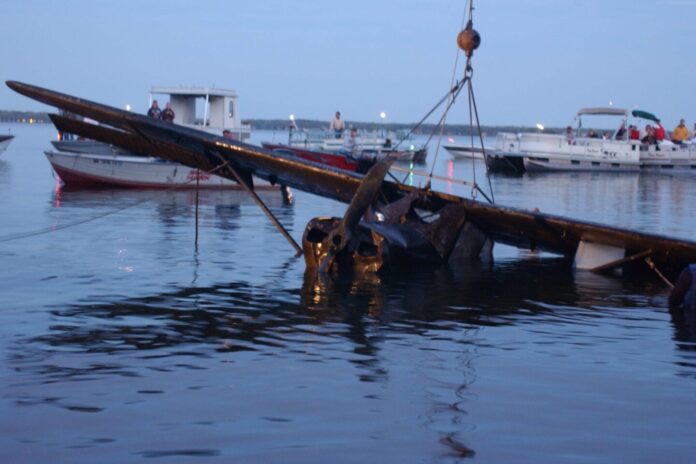For nearly half a century, the people of Spicer, Minnesota, told stories about a small military airplane that had disappeared into Green Lake one foggy night in 1958. The mystery captured imaginations, inspired searches, and became part of local lore. It wasn’t until 2005 that the plane was finally lifted from the lake’s depths, bringing closure to one of Minnesota’s most enduring stories.
On October 15, 1958, Capt. Richard P. Carey of the Minnesota Army National Guard was flying his Cessna L-19 “Birddog” back from Rochester, Minnesota. Carey, 36, encountered heavy fog and reported he was running low on fuel. Shortly after, he radioed that he had hit something. Investigators later believed his low-flying plane had startled a flock of seagulls, which struck the aircraft. That night, witnesses found dead gulls and a small oil slick on Green Lake. Carey’s body was recovered 13 days later, but his plane vanished into the cold, dark waters. For decades, it remained hidden.
Over the years, many tried to find the missing plane. Some used sonar, others scuba-dived, and one even searched with a mini-submarine. Each effort came up short, deepening the legend of the “lost plane of Green Lake.” One man, George Couteur, a longtime water patrol officer, made it his personal mission for decades to locate the wreck. Yet despite all these efforts, the plane stayed hidden in the silt.
The breakthrough came unexpectedly on July 3, 2004. Cory Fladeboe and his cousin, Brett Almquist, were fishing for walleye on Green Lake. Fladeboe had brought along a sonar unit and an underwater camera. As they trolled the waters near a favorite fishing spot, the sonar revealed a strange square-shaped object on the lake bottom. Curious, Fladeboe lowered the camera. To his surprise, the first image that came up showed a plane’s propeller. The cousins quickly realized they had found Capt. Carey’s long-lost Cessna. They returned days later with scuba gear, confirming the tail markings and photographing the wreck. The plane was resting nose-down in about 30 to 40 feet of water, partially buried in silt. For years, its angle and position had made it nearly impossible for older technology to detect.
Excitement quickly spread through the community, and local groups worked together to recover the aircraft. On August 13, 2005, nearly 47 years after it crashed, a volunteer crew led by retired water patrol officer Michael Roe finally brought the plane to the surface. It was a massive effort, lasting over 13 hours. Boats filled with onlookers crowded the lake, while people gathered along the shore to witness history. Divers even recovered some of Carey’s personal belongings, including his wallet, which was returned to his family.
The recovered plane showed little external damage, suggesting Carey had managed to land it on the water. Sadly, he likely escaped the aircraft but succumbed to hypothermia in the freezing October lake before he could reach shore.
At first, there were high hopes to restore the plane and display it as a monument. The Spicer American Legion, with support from state officials, worked on plans to preserve it. However, the project faced setbacks. Restoration costs were estimated at up to $80,000, and when a key supporter, pilot and businessman Gene Underland, died in a separate plane crash in 2009, the effort stalled. The plane’s frame was eventually placed in storage, but the wings were badly deteriorated, and the engine restoration proved too expensive. Over time, the dream of creating a public memorial faded.
Though the restoration never happened, the story of Capt. Carey and his missing plane remains deeply tied to Green Lake and the town of Spicer. The 2005 recovery ended decades of mystery, but it also honored the memory of a pilot who lost his life in service. For those who witnessed the plane’s rise from the water, it was more than just the end of a legend—it was a moment of community history finally coming to light.


